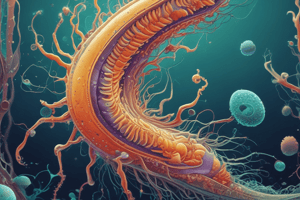Podcast
Questions and Answers
Which characteristic applies to all protozoa?
Which characteristic applies to all protozoa?
- They have a prokaryotic cell structure.
- They can only be free-living.
- They possess membrane-bound organelles. (correct)
- They are multicellular organisms.
What method of locomotion is characteristic of amoeboids?
What method of locomotion is characteristic of amoeboids?
- Spore formation
- Pseudopodia (correct)
- Cilia
- Flagella
Which category of protozoa is known for forming spores during reproduction?
Which category of protozoa is known for forming spores during reproduction?
- Flagellates
- Amoeboids
- Sporozoa (correct)
- Ciliates
What type of nutritional strategy do most protozoa utilize?
What type of nutritional strategy do most protozoa utilize?
In what environment do most protozoa carry out cellular respiration?
In what environment do most protozoa carry out cellular respiration?
Which of the following roles do protozoa fulfill in ecosystems?
Which of the following roles do protozoa fulfill in ecosystems?
Flashcards are hidden until you start studying
Study Notes
Characteristics
- Eukaryotic, single-celled organisms
- Typically microscopic in size
- Possess membrane-bound organelles
- Can be free-living or parasitic
Types of Protozoa
- Amoeboids:
- Irregular shape
- Locomotion by pseudopodia (false feet)
- Examples: Amoeba proteus, Chaos carolinensis
- Flagellates:
- Possess flagella (whip-like structures) for locomotion
- Examples: Giardia lamblia, Trypanosoma cruzi
- Ciliates:
- Possess cilia (hair-like structures) for locomotion and feeding
- Examples: Paramecium caudatum, Stentor coeruleus
- Sporozoa:
- Form spores as a reproductive stage
- Examples: Plasmodium spp. (malaria parasites)
- Apicomplexa:
- Possess apical complex (organelles at the apex of the cell)
- Examples: Toxoplasma gondii, Cryptosporidium parvum
Nutrition and Respiration
- Autotrophic: some protozoa can synthesize their own food through photosynthesis
- Heterotrophic: most protozoa obtain nutrients by consuming other organisms or organic matter
- Aerobic: most protozoa use oxygen for cellular respiration
- Anaerobic: some protozoa can survive without oxygen, using alternative metabolic pathways
Importance of Protozoa
- Decomposers: help break down organic matter in ecosystems
- Food source: serve as a food source for other organisms in aquatic food chains
- Pathogens: some protozoa can cause diseases in humans and animals (e.g., malaria, giardiasis)
- Research models: protozoa are often used as models in scientific research due to their simplicity and ease of manipulation
Characteristics of Protozoa
- Eukaryotic organisms, classified as single-celled.
- Generally microscopic in size, requiring magnification for visibility.
- Contain membrane-bound organelles, differentiating them from prokaryotic organisms.
- Can exist as free-living entities or as parasites, obtaining nutrients in various environments.
Types of Protozoa
-
Amoeboids:
- Exhibit an irregular shape, allowing for flexible movement.
- Move using pseudopodia, which are extensions of their cytoplasm.
- Notable examples include Amoeba proteus and Chaos carolinensis.
-
Flagellates:
- Characterized by the presence of flagella for locomotion; these are whip-like structures.
- Examples include Giardia lamblia, known for causing gastrointestinal infections, and Trypanosoma cruzi, which causes Chagas disease.
-
Ciliates:
- Possess numerous cilia that aid in both movement and feeding.
- Examples include Paramecium caudatum, commonly studied for its cell structure, and Stentor coeruleus, recognized for its large size and unique shape.
-
Sporozoa:
- Have a life cycle that includes spore formation as a reproductive mechanism.
- Critical examples include Plasmodium spp., responsible for malaria transmission.
-
Apicomplexa:
- Feature an apical complex, which consists of specialized organelles at the cell's apex, facilitating host invasion.
- Notable species include Toxoplasma gondii, linked to toxoplasmosis, and Cryptosporidium parvum, a waterborne pathogen.
Nutrition and Respiration
- Autotrophic: Some protozoa can photosynthesize, synthesizing their own food from sunlight.
- Heterotrophic: The majority acquire nutrients by consuming other organisms or decomposing organic material.
- Aerobic Respiration: Most protozoa require oxygen to perform cellular respiration, utilizing it to generate energy.
- Anaerobic Respiration: Certain protozoa can thrive in oxygen-free environments, employing alternative metabolic pathways to survive.
Importance of Protozoa
- Decomposers: Play a vital role in breaking down organic matter, recycling nutrients in ecosystems.
- Food Source: Serve as a crucial link in aquatic food chains, providing nourishment for larger organisms.
- Pathogens: Some species are responsible for diseases affecting humans and animals, such as malaria and giardiasis.
- Research Models: Frequently used in scientific studies due to their simplicity, ease of cultivation, and manipulation, contributing to various fields of biological research.
Studying That Suits You
Use AI to generate personalized quizzes and flashcards to suit your learning preferences.




